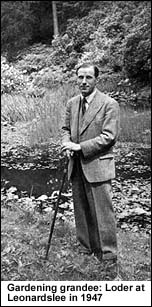Camellia expert whose garden served as the film location for 'Black Narcissus'
SIR GILES LODER, 3rd Bt, who has died aged 84, was a member of one of Britain's
great gardening dynasties, and a prominent figure in the horticultural world
throughout the post-war era.
 For half a century, Loder was one of the Royal Horticultural Society's staunchest
servants, as well as a constant exhibitor - and regular award-winner - in
the society's shows and contests.
For half a century, Loder was one of the Royal Horticultural Society's staunchest
servants, as well as a constant exhibitor - and regular award-winner - in
the society's shows and contests.
The Loder family's vast woodland garden at Leonardslee, near Horsham in
West Sussex, is renowned for the splendour of its rhododendron plantings
overhung by tree magnolias, many of them dating back to the last century.
Just after the last war, Leonardslee presented such a luxuriant a scene
that it was chosen as the location for the 1947 Powell and Pressburger film
of Rumer Godden's novel Black Narcissus, set in the Himalayas.
Regularly open to the public, Leonardslee went on to become, under Giles
Loder's care, a place of pilgrimage for connoisseurs of rhododendrons and
their cousins. Together with his wife Marie, who came from another family
of remarkable gardeners, in the 1940s Loder set about bringing Leonardslee's
plantings up to date.
While the garden was already celebrated for the tree-like plants of the
eponymous Rhododendron loderi, first bred at Leonardslee by Sir Edmund Loder,
1st Bt, in 1900, Giles Loder notably demonstrated the garden value of the
compact-growing R. yakushimanum hybrids which were bred in the post-war
years.
He and his wife also added hundreds of varieties of camellia to the garden,
as an increasing number became available from breeders. And although he
built two greenhouses in which to cultivate the less robust camellias, most
of Loder's plants - many of which are today of enormous size - were grown,
contrary to given horticultural wisdom, on the east-facing slopes of the
lake-based valley in which the garden was created.
Giles Rolls Loder was born on November 10 1914, the son of Captain Robert
Egerton Loder and his wife Muriel Rolls (n e Hoare). Giles's grandfather
Sir Edmund Loder, 2nd Bt, was the eldest son of Robert Loder, sometime MP
for Shoreham, who was created a baronet in 1887. The Loders hailed from
Dorset, where they were settled at Haselbury Bryan by the mid-16th century.
Giles went to Eton and Trinity College, Cambridge. His father having been
killed in the First World War, Giles succeeded in the baronetcy when Sir
Edmund, who had bought the Leonardslee estate in 1887, died in 1920. Giles's
mother maintained the estate until her son was of an age to take charge.
In the Second World War, Loder was commissioned in the 98th (Surrey and
Sussex Yeomanry) Field Brigade, RA, but was subsequently transferred to
the Vosper shipyards, to work on the vessels building there. Boat design
was one of Loder's lifelong interests, and he was for many years a member
of the Royal Yacht Squadron, frequently skippering in races at Cowes.
Although trained for a professional career in engineering, after the war
Loder decided to devote his life to the development of the 1,000-acre Leonardslee
estate and garden.
He went on to receive many gold medals from the RHS for his exhibits at
their Westminster Flower Shows, and in 1997 he was awarded the Loder Cup,
instituted in 1921 by his kinsman Gerald Loder (Lord Wakehurst) for outstanding
work on rhododendrons.
He served several five-year terms as a member of the society's council,
and was for 40 years a member of committees concerned with both plants and
admin-istration.
In 1967 he received the RHS's highest award, the Victoria Medal of Honour
(limited to 63 holders). When, nine years later, his wife also received
the medal, the Loders became one of the very few husband and wife partnerships
to have achieved such a double. In 1993, Giles Loder became a vice-president
of the RHS.
He retired from the management of Leonardslee in 1981, handing it over
to his younger son, who has continued its development and restored it after
the devastating storm of 1987.
Latterly, Giles and Marie Loder went on a series of long journeys, which
included visits to the Antarctic, the Amazon and several African countries,
studying the flora and watching birds.
Loder was High Sheriff of Sussex in 1948-49, and was appointed a Deputy
Lieutenant of West Sussex in 1977.
His wife Marie, whom he married in 1939, was the daughter of Captain Bertram
Symons-Jeune, the notable rock gardener, designer, and breeder of phlox.
Sir Giles and Lady Loder had two sons, Edmund, born in 1941, who succeeds
in the baronetcy, and Robin, the garden custodian.


 For half a century, Loder was one of the Royal Horticultural Society's staunchest
servants, as well as a constant exhibitor - and regular award-winner - in
the society's shows and contests.
For half a century, Loder was one of the Royal Horticultural Society's staunchest
servants, as well as a constant exhibitor - and regular award-winner - in
the society's shows and contests.